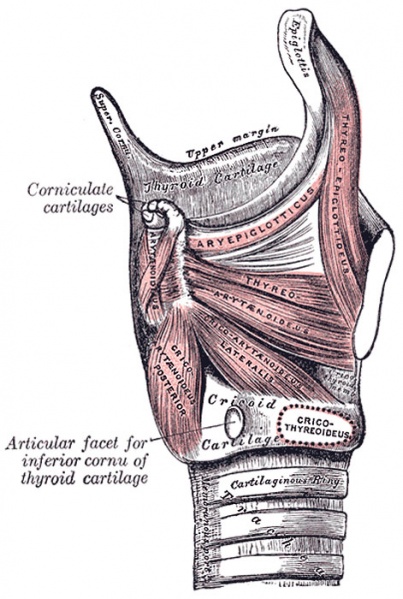File:Gray0959.jpg

Original file (471 × 700 pixels, file size: 91 KB, MIME type: image/jpeg)
Larynx Muscles
Side view of larynx. Right lamina of thyroid cartilage removed.
The Cricoarytænoideus lateralis (lateral cricoarytenoid) (Fig. 959) is smaller than the preceding, and of an oblong form. It arises from the upper border of the arch of the cricoid cartilage, and, passing obliquely upward and backward, is inserted into the front of the muscular process of the arytenoid cartilage.
The Thyreoarytænoideus (Thyroarytenoid) (Figs. 959, 960) is a broad, thin, muscle which lies parallel with and lateral to the vocal fold, and supports the wall of the ventricle and its appendix. It arises in front from the lower half of the angle of the thyroid cartilage, and from the middle cricothyroid ligament. Its fibers pass backward and lateralward, to be inserted into the base and anterior surface of the arytenoid cartilage. The lower and deeper fibers of the muscle can be differentiated as a triangular band which is inserted into the vocal process of the arytenoid cartilage, and into the adjacent portion of its anterior surface; it is termed the Vocalis, and lies parallel with the vocal ligament, to which it is adherent.
A considerable number of the fibers of the Thyreoarytænoideus are prolonged into the aryepiglottic fold, where some of them become lost, while others are continued to the margin of the epiglottis. They have received a distinctive name, Thyreoepiglotticus, and are sometimes described as a separate muscle. A few fibers extend along the wall of the ventricle from the lateral wall of the arytenoid cartilage to the side of the epiglottis and constitute the Ventricularis muscle.
(Text modified from Gray's 1918 Anatomy)
- Larynx Image Links: All cartilages of the larynx | Epiglottis cartilage | Thyroid cartilage | Cricoid cartilage | Arytenoid cartilage | Larynx ligaments anterior | Larynx ligaments posterior | Larynx sagittal section | Larynx and upper trachea | Larynx entrance | Larynx interior | Larynx muscular attachments | Larynx muscles 1 | Larynx muscles 2 | Larynx muscles 3 | Cartilage Development | Respiratory System Development
- Gray's Images: Development | Lymphatic | Neural | Vision | Hearing | Somatosensory | Integumentary | Respiratory | Gastrointestinal | Urogenital | Endocrine | Surface Anatomy | iBook | Historic Disclaimer
| Historic Disclaimer - information about historic embryology pages |
|---|
| Pages where the terms "Historic" (textbooks, papers, people, recommendations) appear on this site, and sections within pages where this disclaimer appears, indicate that the content and scientific understanding are specific to the time of publication. This means that while some scientific descriptions are still accurate, the terminology and interpretation of the developmental mechanisms reflect the understanding at the time of original publication and those of the preceding periods, these terms, interpretations and recommendations may not reflect our current scientific understanding. (More? Embryology History | Historic Embryology Papers) |
| iBook - Gray's Embryology | |
|---|---|

|
|
Reference
Gray H. Anatomy of the human body. (1918) Philadelphia: Lea & Febiger.
Cite this page: Hill, M.A. (2024, April 27) Embryology Gray0959.jpg. Retrieved from https://embryology.med.unsw.edu.au/embryology/index.php/File:Gray0959.jpg
- © Dr Mark Hill 2024, UNSW Embryology ISBN: 978 0 7334 2609 4 - UNSW CRICOS Provider Code No. 00098G
File history
Click on a date/time to view the file as it appeared at that time.
| Date/Time | Thumbnail | Dimensions | User | Comment | |
|---|---|---|---|---|---|
| current | 18:40, 21 August 2012 |  | 471 × 700 (91 KB) | Z8600021 (talk | contribs) | ==Muscles of Larynx== Side view. Right lamina of thyroid cartilage removed. The Cricoarytænoideus lateralis (lateral cricoarytenoid) (Fig. 959) is smaller than the preceding, and of an oblong form. It arises from the upper border of the arch of the cr |
You cannot overwrite this file.
File usage
The following 4 pages use this file:
